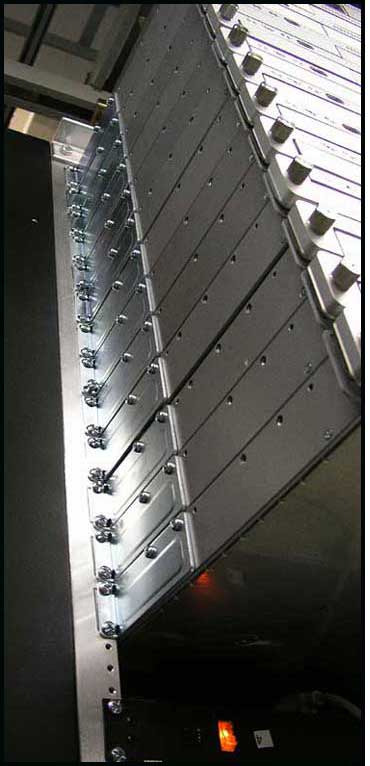The return trip was more eventful than I really wanted it to be. I left SF on Friday afternoon, went to Emeryville to pick up some d.f equipment that was stored there after we shut down the last of the Infoasis T1/DSL network. Then I went to Berkeley to pick up a server from a Bill Woodcock for delivery to d.f. Following that, I drove over the hills to Lafayette for the traditional post-expo BBQ dinner at Michael & Sharon’s house with Shaun Redmond. I ended up staying the night there, and leaving around 6:30 AM.
I made great time for the first half of the journey, and was on-pace to beat my time coming down by a good margin.
Unfortunately…. I stopped to fill the tank and grabbed the wrong can from the trunk. I had two fuel cans, one was a 5-gallon 60/40 mix of petro/VO, the other was 6 gallons, 100% VO. I poured the latter in, and did not realize this for an hour or so. The car ran fine in the rich VO mixture… at first. But as the temp dropped and the fuel thickened things got worse. It seemed that as soon as I got under the Oregon clouds the car didn’t run well. Temps were in the high 30’s and I kept stopping to top it off with dino-juice to thin the mix. It didn’t help because it just kept getting colder. Finally I figured I needed to stop and get some anti-gel at a truck stop or something. I had just passed an exit when the car started to slow way down and the “check engine” light illuminated. Great. Of course another 10 miles rolled by until the next exit… I barely made it up the ramp when the car shuddered to a stop and refused to start. I rolled it back down the slope to a safe spot and got out. Damn it was cold… high 20’s I would guess. Due to my bonehead error earlier I was running a mixture that would be fine if it were in the 70’s, and perhaps even the 60’s but in sub-freezing it was turning to syrup.
I grabbed a jerry can and started walking across the overpass… looking for some Diesel at what appeared to be a truck stop. When I arrived it was closed. Shut down some years ago by the look of it. I started walking back, to fetch the phone and start exploring options when two older gentlemen in a Saturn SUV stopped to inquire about my situation. They informed me that the nearest open station was 6 miles north, and offered me a ride. I gladly accepted. At the station, I bought 5 gallons of Diesel and a bottle of anti-gel. On the way back we discussed alternative fuels a bit, and one of the guys was convinced that Big Oil pays off anyone who publicizes running off an alternative sources with million$ to keep them quiet. Where’s my check? Back at the car I poured in both the dino- and anti-gel-juice and after some hard cranking the engine finally fired and I thanked my saviors profusely. The car ran well for a while but soon it was all it took to keep up with traffic. I could manage 80 MPH on a downhill, but at level I could barely make the speed limit (65) and uphill I was lagging with the trucks. Thankfully I was done with the really big hills and mountains.
I rolled through Portland three and a half hours after I should have, and once within the land of self-serve fuel partook of as much as I could. I looked for Diesel fuel treatment at every stop, but mostly what I found was food & drink and stuff for gasoline. This was one time where the frugal behavior of my car was counter productive. I wanted to burn off that tank fast, but instead the gauge barely moved. Of course the outside temp was plunging… probably into the teens. In Kelso the car died at the bottom of an off-ramp and I walked all over the place looking for Diesel. None at the Shell, or Arco… so I walked under the freeway over to a Target store looking for anti-gel – NONE. The Safeway fuel stop had Diesel so I bought 5 gallons. It was probably a half-mile walk back to the car with the 5 gallon can. Ugh. The car took 3 gallons and started under protest.
Once again, in Olympia the car started losing power badly and I pulled off one exit prior to Sleater-Kinney road. It shuddered to a stop JUST shy of a Shell station. I rolled off into a Shari’s parking lot and walked over to the shell, where I bought some ant-gel. I topped off the tank with both it and some Diesel from my can filled in Kelso and hit the road. The car ran fine through Tacoma and chose the hill approaching the I-5 express lanes to lose power and drop down to 45 MPH. Ugh. Again, level or downhill was fine, but any uphill grade would suck the life out of it… I’d just roll in the far right lane, or even the shoulder and pop the hazard flashers on if I dipped below 50 MPH. I nursed it all the way to 164th in South Everett where I thought it would die. Through some amazing driving through snowy/icy streets and parking lots I managed to get to a Shell station without stopping the car or having to be out of gear for more than a fraction of a second.
Amazingly it did not sputter to a halt, and I parked it facing downhill and let it idle while I topped off the tank from my jerry can. I sat for a while and since the car kept running OK, I ventured back onto the freeway. It was mostly downhill to home. And everything ran fine until Marysville when it once again lost power going over Steamboat Slough. Hazard lights flashing I nursed it along the shoulder to the Quil Ceda Road exit and it died literally as I was pulling into a Shell station forecourt. I coasted over to the Diesel pump and went inside looking for anti-gel. None was to be found so I shoehorned as much fuel as I could (about 2 gallons) onto the top of the tank. The TDIs have a little button inside the filler that allow you to squeeze fuel in past the point where the nozzle shuts off. I literally filled it to the brim, hoping to thin the mix as much as possible.
It took some serious crankage to turn the engine over, but once running, it was its old self again! I could drive as fast as I wanted! Too bad the roads were snowy, or I could have made the last 15 miles in 10 minutes! 😉 I arrived home, unloaded the car at the front door and then parked it in the barn. I turned on the barn’s heater as well. I figured it would help keep the VO from gelling even more.
I left the Bay Area at 6:30 AM. Managed to drive the first half of the trip in 5 hours. The last half took over twice as long, 10.5 hours. Yep, almost 16 hours on the road. 🙁
I managed to timelapse the whole thing. It should be fun to watch, the first part with me passing everything in sight – the last part with me being passed by everything I passed before, and more! I’ll have that up soon.



